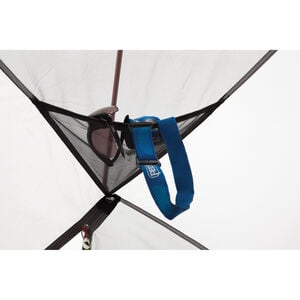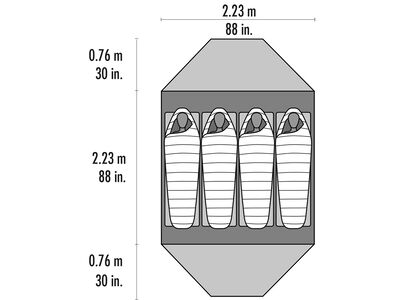Why do actual weights sometimes differ from published weights?
Although we try to be as accurate as possible with our published weights, MSR, like all manufacturers, must make educated guesses as to what the final weights of our tents will be. Because of this, you may notice your tent weighing a few ounces above or below its advertised specs. Such discrepancies are common among tents due to the nature of the product. During the manufacturing process, variations in coatings and fabrics can lead to modest weight differences. In lightweight tents, this equates to a mere ounce or two. In larger tents, it can be a bit more.
Here are a few reasons for those weight variances:
- Coating variances: The thickness in coatings on tent fabric can vary a bit from one tent to another. Fabrics are produced in batches and called “lots,” and there can be a slight weight difference between lots as well as within lots.
- Fabric variances: Because tent fabric is hand cut in up to 200 layers at once, some pieces may be cut just outside the line, making certain parts slightly larger and thus heavier.
- Scale accuracy: At MSR, weights are determined using our calibrated lab scales, which are more accurate than normal household scales.
- Added products: Brands may decide at the last minute to include more stakes or guy cords, which will add to the packaged weight.
To learn more about how we define tent weights, please visit our
blog post on this topic!
What are packaged and minimum weights?
At MSR, we voluntarily follow ASTM International F 1934-98 standards around these two tent industry terms. In accordance with this standard, packaged weight includes the total weight of the packaged contents off the shelf. Minimum weight, by comparison, refers to the combined weight of the tent body, rainfly (if applicable) and tent poles, but not any of the other items that may appear in the package, such as tent stakes, guy cords, stuff sack, etc.
Many MSR backpacking tents can be pitched using only the rainfly, poles and footprint, and in our tent specs we call this non-industry standard setup option our Fast & Light weight.
To learn more about packaged weight vs. minimum, and the manufacturing processes that can affect them, check out our blog post on the topic.
What defines "waterproof" in a tent and what does the "mm" rating mean?
For an MSR tent, waterproof means that all external fabric has been coated with our exceptional polyurethane coatings and the seams are watertight out of the bag. "mm" refers to millimeters and is paired with a number to represent a standardized measurement of how waterproof a coating is. For instance, a 1500mm coating will withstand a 1500mm (5') column of water for more than one minute before a single drop might appear through the fabric. That's strong enough to prevent rain from leaking into a tent in a hurricane-force storm.
Why should I get a footprint?
We recommend that you use an
MSR footprint (sold separately) underneath your tent. Customized to fit each specific model, it will not only keep your tent floor clean and dry, but it will also protect it from excessive abrasion, prolonging the life of the tent. In addition, some of our tents can be set up with just the footprint and fly, creating an incredibly light, minimalist alternative to a full tent.
How do I prevent mildew?
One of the easiest ways to damage your tent is by not drying it as quickly as possible after it gets wet. Storing a wet tent for as little as 24 hours in warm weather is likely to start the process of mildew formation. Mildew can permanently damage the waterproof coatings by causing them to separate from the fabric, but mild to severe staining is more common. Mildew stains are permanent. They cannot be removed without potential harm to the fabric coatings and are not covered by warranty. Even when your tent appears to be dry after use, it is always best to assure it is completely dry before storing. Hang it outside or pile it loosely in your house for a few days, turning it inside and out to assure it has dried everywhere. Never machine dry your tent as the heat can melt the fabric.
How do I seam seal my tent?
If you start to notice leaks along your seams, seam sealing can make them waterproof again, extending the life of your tent. The process can be easier than you might think. We put together this video to help guide you through.
What's the best way to clean my tent?
Cleaning your tent is not necessary unless it has an offensive odor or becomes heavily soiled. If heavily soiled, the pressure from a regular garden hose will remove most loose dirt. For more severe cleaning, set up your tent and hand wash it with warm water, a sponge and mild, non-detergent soap. Do not use dishwashing liquid, detergent, bleach, pre-soaking solutions, or spot removers. Rinse well. Dry your tent by pitching it or line-drying it. Never dry clean, machine- wash or machine-dry your tent. Any of these methods can remove all the waterproof coatings from the tent.
Are the shorter Hubba Hubba Bikepacking tent poles compatible with other Hubba Hubba series tents?
The shorter tent poles for our new Hubba Hubba 1 and Hubba Hubba 2 bikepacking tents will not work for previous generation Hubba Hubba tent series (non-bikepacking models). This is due to the specific geometry and design configuration. These pole sets are made out of different materials and the arc and curvature of the tent is actually different because of it. The tent body is then designed differently to fit snugly within that curvature, and thus, the two different tent poles are not interchangeable in between these models.
Another question we get asked is whether or not the front mount bikepacking bag/stuff sack can be purchased separately to be used with a different (non-packing) Hubba Hubba series tent. The short answer is no, because the bikepacking tent poles are shorter - one of the main draws of this design for packability purposes, and it's ability to fit well between handlebars. The longer pole sets on other models will not fit into the Hubba Hubba bikepacking tent front mount stuff sack.
Do you need tent poles for your non MSR tent, such as Walrus or Moss?
For any tent poles that we do not make/no longer make (Moss, Walrus, etc.), please check with
Tent Pole Technologies for information.
What happens if one of my poles breaks?
If a tent pole breaks, you can make a temporary splint with the
pole repair sleeve. Slide the repair sleeve over the broken section and tape or wedge in place with a stick to hold it secure.
What do the letters D and T after the fabrics mean?
"D" stands for Denier. It's a numbering system for fibers, filaments and yarns, in which the lower numbers are lighter/finer and the higher numbers heavier/coarser. "T" stands for Thread Count – specifically the number of warp and fill threads in a square inch. The lower numbers represent a loosely woven fabric and the higher number a tightly woven fabric. These two numbers together help indicate the strength and feel of a piece of fabric.
What are some different configuration of the tarps and wings?
The 7-point design has a "flat" and a "pointed" end. For all configurations, the "pointed end" should always be used as the highest supported point. The opposite "flat edge," which consists of three points, can be stretched tightly and attached to a shelter, car rack, or even the pole-supported vestibule of a tent to form a protected area. Try placing the poles at different points, using no poles at all or adding more poles to create new living spaces. (Paddles and sticks work well in the cord storage pockets, too.) Experiment and be creative!
How should I store my tent?
Never pack or store your tent if it is wet, damp or dirty. Although we use the best polyurethane waterproofing available, prolonged exposure to moisture causes hydrolysis which, in turn, causes the waterproof layer to break down, becoming soft, sticky and no longer waterproof. Storing a wet tent for as little as 24 hours in warm weather is also likely to start the process of mildew forming on the fabric. Mildew will cause your tent to stain, smell and will also lead to the premature breakdown of the waterproof coating. Mildew and moisture damage are not covered under the Limited Warranty.
For long-term storage, keep your tent in a dry and cool area, out of direct sunlight. Store it outside of its stuff sack, as you would a sleeping bag, in a breathable, over-sized cotton or mesh duffel for protection. On the cheap, an old pillowcase is ideal.
How do I guy out my tent with the included tensioners?
Guying out your tent will provide more stability in windy or extreme conditions while also maximizing ventilation. To guy out your tent, run cord from the tent's guy point through the tensioner. Pass the cord around the stake and back through the tensioner, keeping the curved side of the tensioner toward the stake. Tie a knot at the end of the cord. To tighten cord, pull the tensioner up along the cord and release.
What causes condensation and how do I reduce it in my tent?
Condensation is the build-up of moisture inside your tent due to differences between the inside and outside temperatures. There are three main sources:
- Weather Conditions: High humidity, low temperatures, and rainy conditions create the most condensation.
- People: We produce about 1 - 2 pints of moisture per night through breathing and skin evaporation.
- Wet Environment: Wet ground or wet gear stored inside the tent.
While no tent design can eliminate condensation, the key to reducing it is ventilation. Cooler, drier air has to flow into your tent and warm, moist air must escape. We have designed a variety of ways to do this.
To start, the tent body and ceiling are made of breathable and mesh fabrics. This allows moisture to escape the interior of your tent. However, it must also be able to escape the waterproof fly, and every MSR rainfly has a peak vent that provides protection from the outside, while still allowing essential, free-flowing fresh air to move through your tent. You can also leave a door open in good weather, or take advantage of the double sliders on the doors to vent from the top where warm and moist air tends to accumulate. Make sure to leave at least two vents open if possible, allowing any breeze to provide cross-flow ventilation for maximum circulation. Guying out your rainfly will also increase ventilation in hot or humid conditions.
Video:
What causes condensation in a tent
How long will a tent last?
A tent's lifespan is directly connected to the amount you use it. A tent's biggest enemy is UV radiation (just like your skin). A tent that lives in extreme conditions at high altitude, such as Everest Base Camp, may only last a few months, while a well taken care of tent, used occasionally under normal conditions, can last for many years.
Does MSR sell tent pole sets by themselves?
Yes, we do sell tent pole sets by themselves – just contact us
here if you need a replacement. Please note, our pole sets are only compatible with the specific tent model they are designed to fit.




























